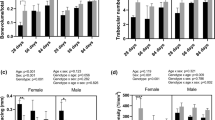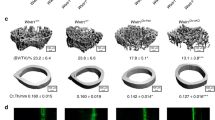Abstract
Among the four prostaglandin E receptor subtypes, EP4 has been implicated as an important regulator of both bone formation and bone resorption; however, the integrated activities of this receptor on bone biomechanical properties have not been examined previously. This study compared the bone biomechanical properties of EP4 knockout (KO) transgenic mice to strain-matched wild-type (WT) controls. We examined two groups of adult female mice: WT (n = 12) and EP4 KO (n = 12). Femurs were tested in three-point bending and the lumbar-4 (L4) vertebral body by compression. Distal femur and vertebral body trabecular bone architecture were quantified using micro-computed tomography. Biomechanical structural parameters (ultimate/yield load, stiffness) were measured and apparent material parameters (ultimate/yield stress, modulus) calculated. Body weights and bone sizes were not different between EP4 KO and WT mice (P > 0.05, Student’s t-test). EP4 KO mice exhibited reduced structural (ultimate/yield load) and apparent material (ultimate/yield stress) strength in the femoral shaft and vertebral body compared to WT (P < 0.05). Vertebral body stiffness and femoral neck ultimate load (structural strength) were marginally lower in EP4 KO than that in WT mice (P < 0.1). In addition, EP4 KO mice have smaller distal femur and vertebral bone volume to total volume (BV/TV) trabecular thickness than WT mice (P < 0.05). These results suggest that the prostaglandin receptor EP4 has an important role in determining biomechanical competence in the mouse skeleton. Despite similar bone size, the absence of an EP4 receptor may have removed a necessary link for bone adaptation pathways, which resulted in relatively weaker bone properties.
Similar content being viewed by others
References
Pilbeam CC, Harrison JR, Raisz LG (2002) Prostaglandins and bone metabolism. In: Bilizekian JP, Raisz LG, Rodan GA, editor. Principles of bone biology. 2nd ed. Academic Press, San Diego: pp 979–994
Akamine T, Jee WS, Ke HZ, Li XJ, Lin BY (1992) Prostaglandin E2 prevents bone loss and adds extra bone to immobilized distal femoral metaphysis in female rats. Bone 13:11–22
Ito H, Ke HZ, Jee WS, Sakou T (1993) Anabolic responses of an adult cancellous bone site to prostaglandin E2 in the rat. Bone Miner 21:219–236
Jee WS, Ke HZ, Li XJ (1991) Long-term anabolic effects of prostaglandin E2 on tibial diaphyseal bone in male rats. Bone Miner. 15:33–55
Jee WS, Mori S, Li XJ, Chan S (1990) Prostaglandin E2 enhances cortical bone mass and activates intracortical bone remodeling in intact and ovariectomized female rats. Bone 11:253–266
Jee WS, Ueno K, Deng YP, Woodbury DM (1985) The effects of prostaglandin E2 in growing rats: Increased metaphyseal hard tissue and cortico-endosteal bone formation. Calcif Tissue Int. 37:148–157
Jee WS, Ueno K, Kimmel DB, Woodbury DM, Price P, Woodbury LA (1987) The role of bone cells in increasing metaphyseal hard tissue on rapidly growing rats treated with prostaglandin E2. Bone 8:171–178
Mori S, Jee WS, Li XJ (1992) Production of new trabecular bone in osteopenic ovariectomized rats by prostaglandin E2. Calcif. Tissue Int 50:80–87
Mori S, Jee WS, Li XJ, Chan S, Kimmel DB (1990) Effects of prostaglandin E2 on production of new cancellous bone in the axial skeleton of ovariectomized rats. Bone 11:103–113
Ueno K, Haba T, Woodbury D, Price P, Anderson R, Jee WSS (1985) The effects of prostaglandin E2 in rapidly growing rats: Depressed longitudinal and radial growth and increased metaphyseal hard tissue mass. Bone 6:79–86
Tang LY, Cullen DM, Yee JA, Jee WS, Kimmel DB (1997) Prostaglandin E2 increases the skeletal response to mechanical loading. J Bone Miner Res 12(2): 276–82
High WB (1987) Effects of orally administered prostaglandin E-2 on cortical bone turnover in adult dogs: a histomorphometric study. Bone 8: 363–373
Yang RS, Liu TK, Lin-Shiau SY (1993) Increased bone growth by local prostaglandin E2 in rats. Calcif. Tissue Int. 52: 57–61
Sasaoka R, Terai H, Toyoda H, Imai Y, Sugama R, Takaoka K (2004) A prostanoid receptor EP4 agonist enhances ectopic bone formation induced by recombinant human bone morphogenetic protein-2. Biochem Biophys Res Commun 318(3): 704–709
Marks SC Jr, Miller S (1988) Local infusion of prostaglandin E1 stimultes mandibular bone formation in vivo. Journal of Oral Pathology 17(9–10):500–505
Suponitzky I, Weinreb M (1998) Differential effects of systemic prostaglandin E2 on bone mass in rat long bones and calvariae. J Endocrinol 156(1): 51–57
Jorgensen HR, Svanholm H, Host A (1998) Bone formation induced in an infant by systemic prostaglandin-E2 administration. Acta Orthop Scand 59(4): 464–466
Li XJ, Jee WS, Li YL, Patterson Buckendahl P (1990) Transient effects of subcutaneously administered prostaglandin E2 on cancellous and cortical bone in young adult dogs. Bone 11: 353–364
Fujita D, Yamashita N, Iita S, Amano H, Yamada S, Sakamoto K (2003) Prostaglandin E2 induced the differentiation of osteoclasts in mouse osteoblast-depleted bone marrow cells. Prostaglandins Leukot Essent Fatty Acids 68(5): 351–358
Tomita M, Li X, Okada Y, Woodiel FN, Young RN, Pilbeam CC, Raisz LG (2002) Effects of selective prostaglandin EP4 receptor antagonist on osteoclast formation and bone resorption in vitro. Bone 30(1): 159–163
Sakuma Y, Tanaka K, Suda M, Yasoda A, Natsui K, Tanaka I, Ushikubi F, Narumiya S, Segi E, Sugimoto Y, Ichikawa A, Nakao K (2000) Crucial involvement of the EP4 subtype of prostaglandin E receptor in osteoclast formation by proinflammatory cytokines and lipopolysaccharide. J Bone Min Res 15:218–227
McCoy JM, Wicks JR, Audoly LP (2002) The role of prostaglandin E2 receptors in the pathogenesis of rheumatoid arthritis. J Clin Invest 110(5): 651–658
Sakuma Y, Tanaka K, Suda M, Komatsu Y, Yasoda A, Miura M, Ozasa A, Narumiya S, Sugimoto Y, Ichikawa A, Ushikubi F, Nakao K (2000) Impaired bone resorption by lipopolysaccharide in vivo in mice deficient in the prostaglandin E receptor EP4 subtype. Infect Immun 68(12): 6819–6825
Breyer RM, Bagdassarian CK, Myers SA, Breyer MD (2001) Prostanoid receptors: subtypes and signaling. Annual Review of Pharmacology and Toxicology 41:661–690
Suda M, Tanaka K, Natsui K, Usui T, Tanaka I, Fukushima M, Shigeno C, Konishi J, Narumiya S, Ichikawa A, Nakao N (1996) Prostaglandin E receptor subtypes in mouse osteoblastic cell line. Endocrinology 137(5): 1698–1705
Suda M, Tanaka K, Yasoda A, Natsui K, Sakuma Y, Tanaka I, Ushikubi F, Narumiya S, Nakao K (1998) Prostaglandin E2 (PGE2) autoamplifies its production through EP1 subtype of PGE receptor in mouse osteoblastic MC3T3-E1 cells. Calcif Tissue Int 62(4): 327– 331
Woodiel FN, Fall PM, Raisz LG (1996) Anabolic effects of prostaglandins in cultured fetal rat calvariae: structure-activity relations and signal transduction pathway. Journal of Bone and Mineral Research the Official Journal of the American Society for Bone and Mineral Research 11(9):1249–1255
Fujieda M, Kiriu M, Mizuochi S, Hagiya Ki, Kaneki H, Ide H (1999) Formation of mineralized bone nodules by rat calvarial osteoblasts decreases with donor age due to a reduction in signaling through EP(1) subtype of prostaglandin E(2) receptor. J Cell Biochem 75(2): 215–225
Hakeda Y, Yoshino T, Natakani Y, Kurihara N, Maeda N, Kumegawa M (1986) Prostaglandin E2 stimulates DNA synthesis by a cyclic AMP-independent pathway in osteoblastic clone MC3T3-E1 cells. Cell Physiol 128(2): 155–161: 0021–9541
Raisz LG, Fall PM (1990) Biphasic effects of prostaglandin E2 on bone formation in cultured fetal rat calvariae: interaction with cortisol. Endocrinology 126: 1645–1659
Suzawa T, Miyaura C, Inada M, Maruyama T, Sugimoto Y, Ushikubi F, Ichikawa A, Narumiya S, Suda T (2000) The role of prostaglandin E receptor subtypes (EP1, EP2, EP3, and EP4) in bone resorption: An analysis using specific agonists for the respective EPs. Endocrinology. 141(4): 1554–1559
Li X, Okada Y, Pilbeam CC, Lorenzo JA, Kennedy CR, Breyer RM, Raisz LG (2000) Knockout of the murine prostaglandin EP2 receptor impairs osteoclastogenesis in vitro. Endocrinology 141(6):2054–2061
Yoshida K, Oida H, Kobayashi T, Maruyama T, Tanaka M, Katayama T, Yamaguchi K, Segi E, Tsuboyama T, Matsushita M, Ito K, Ito Y, Sugimoto Y, Ushikubi F, Ohuchida S, Kondo K, Nakamura T, Narumiya S (2002) Stimulation of bone formation and prevention of bone loss by prostaglandin E EP4 receptor activation. Proc Natl Acad Sci USA 99(7): 4580–4585
Li M, Healy DR, Li Y, Simmons HA, Crawford DT, Ke HZ, Pan LC, Brown TA, Thompson DD (2005) Osteopenia and impaired fracture healing in aged EP4 receptor knockout mice. Bone 37(1):46–54
Akhter MP, Cullen DM, Gong G, Recker RR (2001) Bone biomechanical properties in prostaglandin EP1 and EP2 knockout mice. Bone 29(2): 121–125
Muller R, Ruegsegger P (1997) Micro-tomographic imaging for the nondestructive evaluation of trabecular bone architecture. Stud Health Technol Inform. 40:121–125
Muller R, Hahn M, Vogel M, Delling G, Ruegsegger P (1996) Morphometric analysis of noninvasively assessed bone biopsies: comparison of high-resolution computed tomography and histologic sections. Bone 18(3): 215–220
Suetsugu H, Ishihara S, Moriyama N, Kazumori H, Adachi K, Fukuda R, Watanabe M, Kinoshita Y (2000) Effect of rebamipide on prostaglandin EP4 receptor gene expression in rat gastric mucosa. J Lab Clin Med 136: 50–57
Akhter MP, Fan Z, Rho J-Y (2004) Bone intrinsic material properties in three inbred mouse strains. Calcif Tissue Int 75(5): 416–420
Weinreb M, Grosskopf A, Shir N (1999) The anabolic effect of PGE2 in rat bone marrow cultures is mediated via the EP4 receptor subtype. Am J Physiol 276(2 Pt 1): E376–E383
Nguyen MT, Camenisch T, Snouwaert JN, Hicks E, Coffman TM, Anderson PA, Malouf NN, Koller BH (1997) The prostaglandin receptor EP4 triggers remodelling of the cardiovascular system at birth. Nature 390(6655): 78–81
Audoly LP, Tilley SL, Goulet J, Key M, Nguyen MT, Stock JL, McNeish JD, Koller BH, Coffman TM (1999) Identification of specific EP receptors responsible for the hemodynamic effects of PGE2. Am J Phys 277(3 Pt 2): H924–H930
Nataraj C, Thomas DW, Tilley SL, Nguyen MT, Mannon R, Koller BH, Coffman TM (2001) Receptors for prostaglandin E2 that regulate cellular immune responses in the mouse. Journal of Clinical Investigation 108(8): 1229–1235
Miyaura C, Inada M, Suzawa T, Sugimoto Y, Ushikubi F, Ichikawa A, Narymiya S, Suda T (2000) Impaired bone resorption to prostaglandin E2 in prostaglandin E receptor EP4-knockout mice. J Biol Chem 275: 19819–19823
Acknowledgments
We thank Daniel Wells, Nick Glass, Andy Lund, and Bryan McGuckin for their assistance. We also thank Dominique Brees (Pathology Department, Pfizer Global Research and Development) for histopathological assessment of mice. This study was partially supported by funds from the State of Nebraska (LB595).
Author information
Authors and Affiliations
Corresponding author
Rights and permissions
About this article
Cite this article
Akhter, M.P., Cullen, D.M. & Pan, L.C. Bone Biomechanical Properties in EP4 Knockout Mice. Calcif Tissue Int 78, 357–362 (2006). https://doi.org/10.1007/s00223-005-0186-5
Received:
Accepted:
Published:
Issue Date:
DOI: https://doi.org/10.1007/s00223-005-0186-5




